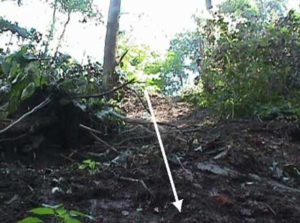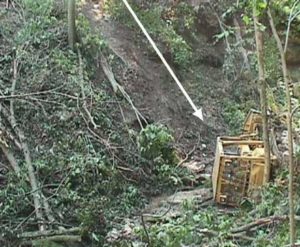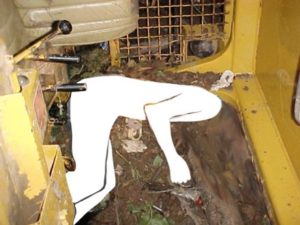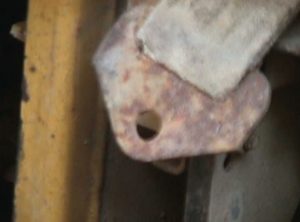SUMMARY
On August 13, 2003, a 46-year-old unrestrained male-heavy equipment operator (victim) died of injuries sustained when the dozer he was operating slid backwards then rolled down a steep bank landing on top of him. The victim, who was working alone at the time, was constructing a skid road. It appeared that the victim had finished constructing a road parallel to the hillside and then backed down onto the steep hillside below the road. Tracks indicated that as he attempted to go back up the hill, his forward progress ended with the dozer’s tracks spinning and digging deep ruts. He then began to back further down the slope. At some point, the dozer began to slide backward until reaching a near-vertical grade above a creek. The dozer continued to slide down the steep grade approximately 70 feet until it rolled and landed on its side in the creek. The unrestrained operator was pinned under the rear support member of the dozer’s rollover protective structure (ROPS). Later that evening, two acquaintances of the victim became concerned after seeing his car parked on the road above the logging site. They discovered the overturned dozer and the victim pinned beneath and immediately contacted EMS who arrived shortly thereafter. The victim was transported to a medical facility and pronounced dead.
The WV FACE investigator concluded that to reduce the likelihood of similar occurrences, employers should:
- ensure that machines, including those provided by employees, are maintained in serviceable condition and that available safety devices are used while the equipment is being operated.
INTRODUCTION
On August 15, 2003, the WV FACE Program was notified by the West Virginia Division of Forestry (WVDOF) of a heavy equipment work-related fatality that had occurred on August 13, 2003, at a logging site. The WV FACE field investigator and the WVDOF representative traveled to the site on August 18, 2003, and met with the logging company’s owner to discuss the incident. The owner then accompanied the investigator to the incident site. The bulldozer was examined and photographs and measurements were taken. The death certificate and medical examiner’s report were obtained, as well as the County Sheriff’s Department Investigative Report and photographs.
The privately-owned 20-acre timber stand was being selectively logged for saw timber and pulpwood.
The employer in this incident was a commercial logging company that had been in business for 15 years. At the time of the incident, the operation’s workforce totaled 3. The owner would fell the timber, another worker would hook up cable for skidding, and the victim would use a dozer to skid the logs to the operation’s landing. The victim also did some log site road construction. At the time of the incident, the logging operation was loosely structured with the dozer operator (victim) and hook-up man working from day-to-day, as needed. The owner did not indicate that formal company-specific safety training was provided.
The owner held Certified Logger status in West Virginia. [Note: The Logging Sediment Control Act of West Virginia (1992) requires that each timbering operation in West Virginia be supervised by a certified logger. To become a certified logger, an individual is required to complete training and pass a test for best management practices (a soil erosion prevention plan) and chain saw safety as well as possess a current first aid card.1 ]
The victim’s job at the time of the incident was that of a dozer operator. It was reported that he was an experienced operator. He had been sporadically working for the company for approximately 3 weeks when the incident occurred. The dozer was owned by the victim’s brother, who was not associated with the logging operation.
INVESTIGATION
On August 13, 2003, a 46-year-old unrestrained male-heavy equipment operator (victim) died of injuries sustained when the dozer he was operating slid backward then rolled down a steep bank landing on top of him. The victim, who was working alone at the time, was constructing a skid road. It appeared that the victim had finished constructing a road parallel to the hillside and then backed down onto the steep hillside below the road (see Figure 1). Tracks indicated that as he attempted to go back up the hill, forward progress ended with the dozer’s tracks spinning and digging deep ruts. Tracks further indicated that he then began to back further down the slope. At some point, the dozer began to slide backward until reaching a near-vertical grade above a creek (see Figure 2). The dozer continued to slide down the steep grade approximately 70 feet until it rolled and landed on its side in the creek (see Figure 3). The unrestrained operator was pinned under the rear support member of the dozer’s ROPS (see Figure 4). Later that evening, two acquaintances of the victim became concerned after seeing his car parked on the road above the logging site. They discovered the overturned dozer and the victim pinned beneath and immediately contacted EMS who arrived shortly thereafter. The victim was transported to a medical facility and pronounced dead.
CAUSE OF DEATH
The cause of death listed on the death certificate was multiple crush injuries.
RECOMMENDATIONS/DISCUSSION
Recommendation #1: Employers should ensure that machines, including those provided by employees, are maintained in serviceable condition and that available safety devices are used while the equipment is being operated.
Discussion:
The dozer’s seat belt was rusted and in a state of disrepair (see Figure 5). Evidence suggests that the belt had not been recently used. Equipment should be inspected as it arrives on site and defects or damage repaired or the unserviceable machines should not be operated. It is important to realize that a machine with a defective safety device is considered to be unserviceable. The OSHA Logging Standard CFR 1910.266 (f)(1)(i) requires that the employer assure that each machine, including any machine provided by an employee, is maintained in serviceable condition.2 Furthermore, 1910.266 (d)(3)(ii) & (iii) requires the use of an available seat belt while the machine is being operated to restrain the employee in the machine’s cab.2 It is unknown whether the operator would have used the belt had it been functional. However, it is the employer’s responsibility to ensure such use if it is functional or remove the machine from service. Had the defective seat belt been identified and repaired before allowing the victim to operate the equipment and had the employer made seat belt use a condition of employment, the seat belt would have kept the victim within the safety zone provided by the cab’s ROPS, and the fatal incident may have been avoided.
REFERENCES
- West Virginia Logging Sediment Control Act, 1992.
- Office of the Federal Register: Federal Register, Vol. 59, No. 196, 29 CFR 1910.266.
ILLUSTRATIONS
 |
| Figure 1. From left to right is the path the bulldozer followed while backing out of the newly constructed skid road. The end of the dotted line on the right depicts the nearly vertical drop-off. |
 |
| Figure 2. This photo shows the steep bank the dozer began to slide down backward before rolling over. The white arrow represents the path of the sliding dozer. |
 |
| Figure 3. This photo shows the section of the bank where the rollover occurred and the dozer’s final resting place. |
 |
| Figure 4. The victim’s position after the rollover. |
 |
| Figure 5. This photo shows the condition of the operator’s restraint system. |
FATALITY ASSESSMENT AND CONTROL EVALUATION PROGRAM
The WVU Center for Rural Emergency Medicine, through a contract with the West Virginia Department of Health and Human Resources and Bureau for Public Health, conducts investigations on the causes of work-related fatalities within the state. The goal of this program is to prevent future fatal workplace injuries. West Virginia FACE intends to achieve this goal by identifying and studying the risk factors that contribute to workplace fatalities, by recommending intervention strategies, and by disseminating prevention information to employers, employees, trade associations, unions, equipment manufacturers, students, teachers, and others with an interest in workplace safety.
Please use the information listed on the Contact Sheet on the NIOSH FACE website to contact In-house FACE program personnel regarding In-house FACE reports and to gain assistance when State-FACE program personnel cannot be reached.


